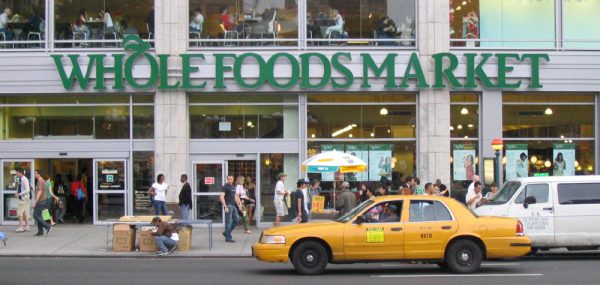Whole Foods Policy Trades Produce for Profits
Whole Foods at Columbus Circle is popular among Fordham residents.(Courtesy of Aspersions via Flickr)
February 15, 2018
Across the country, Whole Foods Market has experienced food shortages due to an inventory management system called order-to-shelf (OTS), a program implemented early last year that promised to slash prices and reduce food waste. The new policy left many stores throughout Manhattan with empty aisles and prolonged frustrations for both employees and customers, though our own Columbus Circle location has yet to feel its full effects.
OTS sought to streamline the path of a product from shipment to shopping bag by avoiding stock rooms almost entirely, instructing stores to carry only enough product to stock a shelf with minimal overflow. While this method reduced the risk of food spoilage, it left storefronts susceptible to surprise incidents of increased customer demands or delayed deliveries—any abnormalities could result in food shortages and bare shelves.
Since Amazon bought Whole Foods last August for $13.7 billion, the grocery chain has seen a dramatic drop in prices and a subsequent uptick in customer traffic. In combination with OTS, initiated by Whole Foods before Amazon’s acquisition, these recent changes have created an incompatibility between supply and demand: customers are greeted by stands emptied of essential products from potatoes to ready-made meals.
A new manual prohibited “re-facing,” a common practice of replacing sold-out products with different storeroom items to cover gaps in stock. With this new policy, sold-out shelf space remains empty, confronting customers with empty aisles and diminishing the amount of produce on display in the market. Whole Foods planned to save $300 million on produce by 2020 thanks to OTS’ cost-cutting—in the meantime, it is losing valuable customer sales.
Many Fordham students frequent the Columbus Circle Whole Foods for its affordable prices, product variety and transparency surrounding its suppliers. Cici Ogden, Fordham College at Lincoln Center (FCLC) ’20, said, “I need to know where my food comes from. At Whole Foods, there’s more information available.” Ogden found that the store’s clear labels regarding a product’s origins and ingredients help her manage her dietary restrictions in ways Trader Joe’s or other grocery chains cannot.
Additionally, OTS’ grip on inventory shifted purchasing power from local buyers to Whole Foods’ headquarters in Austin, Texas, threatening to divest individual store owners of their control over sourcing local foods unique to each location.
Though the move to a unified system of purchasing promised to save the company money and has not yet significantly affected local producers, shoppers fear their neighborhood Whole Foods may discontinue niche favorites. “Our Whole Foods has a lot of food that’s local,” Ogden said, referring to a favorite brand of tomato sauce produced in a local New York kitchen. “If that changes, that would be disappointing.”
Columbus Circle shoppers have yet to notice the effects of OTS on their Whole Foods, reporting fully-stocked aisles and displays teeming with produce. Customers and employees attributed the plentitude of products to the store’s central location and increasing popularity, which afford the location ample storage.
Estimates for company savings from OTS projected into 2020, indicating little incentive from Whole Foods or Amazon to find a solution for customer frustration. While OTS remains in place, it will ultimately be Amazon’s decision whether to save on produce or rescue customer sales.













